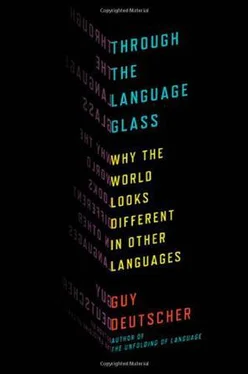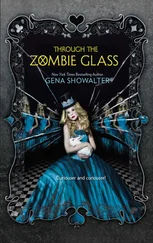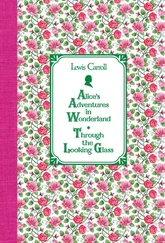Surely, there could have been only one possible conclusion for such an acutely intelligent researcher to draw from his own findings: the differences in color vocabulary have nothing to do with biological factors. And yet there was one experience which struck Rivers so forcefully that it managed to throw him entirely off track. This was the encounter with that weirdest of all weirdnesses, a phenomenon which philologists could infer only from ancient texts but which he met face to face: people who call the sky “black.” As Rivers points out with amazement in his expedition reports, he simply could not grasp how the old men of Murray Island regarded it as quite natural to apply the term “black” ( golegole ) to the brilliant blue of the sky and sea. He mentions with equal disbelief that one of the islanders, “an intelligent native,” was happy to compare the color of the sky to that of dark dirty water. This behavior, Rivers writes, “seemed almost inexplicable, if blue were not to these natives a duller and a darker colour than it is to us.”
Rivers thus concluded that Magnus was right in assuming that the natives must still suffer from a “certain degree of insensitiveness to blue (and probably green) as compared with that of Europeans.” Being such a scrupulous scientist, Rivers was not only aware of the weaknesses of his own argument but careful to air them himself. He explains that his own results proved that one cannot deduce from language what the speakers can see. He even mentions that the younger generation of speakers, who have borrowed the word bulu-bulu for “blue,” use it without any apparent confusion. And still, after acknowledging all such objections, he parries them with one fact, as if it were sufficient to undermine everything else: “One cannot, however, wholly ignore the fact that intelligent natives would regard it as perfectly natural to apply the same name to the brilliant blue of the sky and sea which they give to the deepest black.”
LEGACY FRUIT AND OTHER THOUGHT EXPERIMENTS
At the last hurdle, then, Rivers’s imagination simply lost its nerve and balked at the idea that “blue” is ultimately a cultural convention. He could not bring himself to concede that people who saw blue just as vividly as he did would still find it natural to regard it as a shade of black. And in all fairness, it is difficult to blame him, for even with the wealth of incontrovertible evidence at our disposal today, it is still very hard for us to muster the imagination needed to accept that blue and black seem separate colors just because of the cultural conventions we were reared on. Our deepest instincts and guttest of feelings yell at us that blue and black are really separate colors, as are green and blue, whereas navy blue and sky blue, for instance, are really just different shades of the same color. So before we continue with the final episode of the quest for the origin of the color sense, we can take a short break from the historical narrative and embark on three thought experiments that might help to make the power of cultural conventions sink in.
The first experiment is an exercise in counterfactual history. Let’s imagine how the color-sense debate might have unfolded had it been conducted not in England and Germany but in Russia. Imagine that a nineteenth-century Russian anthropologist, Yuri Magnovievitch Gladonov, goes on an expedition to the remote British Isles off the northern coast of Europe, where he spends a few months with the reclusive natives and conducts detailed psychological tests on their physical and mental skills. On his return, he surprises the Royal Academy of Sciences in St. Petersburg with a sensational report. It turns out that the natives of Britain show the most curious confusions in their color terminology in the siniy and goluboy area of spectrum. In fact, the aboriginal population of those cloud-swept isles does not distinguish between siniy and goluboy at all and calls them by the same name! At first, Gladonov says, he assumed the natives had a defect in their vision, perhaps because of lack of sufficient sunlight during most of the year. But when he tested their eyesight, he found that they could distinguish perfectly well between siniy and goluboy . It was just that they insisted on calling both these colors “blue.” If pressed to explain the difference between these two colors, they would say that one was “dark blue” and the other “light blue.” But they insisted it was “ridiculous” to call these two shades different colors.
Now, when the mirror is turned on our own linguistic vagueness, the idea that our “defective” color vocabulary has anything to do with defective eyesight immediately appears ludicrous. Of course English speakers can see the difference between navy blue and sky blue. It’s simply that their cultural conventions regard these as shades of the same color (even though the two colors actually differ by wavelength just as much as sky blue does from green, as can be seen in the picture of the spectrum in figure 11). But if we can bring ourselves to view the spectrum through Russian eyes and look at siniy and goluboy as two separate colors, it might also become a little easier to empathize with those clueless primitives who do not separate “blue” from “green,” for instance. Just as English lumps goluboy and siniy under one “blue” concept, other languages extend this lumping principle to the whole green-blue range. And if you happened to grow up in a culture where this chunk of the spectrum has just one label, let’s say “grue,” wouldn’t it seem silly that some languages treat leaf grue and sea grue as two separate colors rather than as two shades of the same color?

The second thought experiment may require less imagination than the first, but it needs some precious equipment. Rivers did not have children of his own, but it is tempting to think that if he had examined Western children’s struggles with color, he might not have been so flummoxed by the Torres Strait islanders. Scientists have long been aware that children’s acquisition of color vocabulary is remarkably slow and laborious. And yet the acuteness of the difficulties never fails to amaze. Charles Darwin wrote that he had “attended carefully to the mental development of my young children, and with two, or as I believe three of them, soon after they had come to the age when they knew the names of all common objects, I was startled by observing that they seemed quite incapable of affixing the right names to the colours in coloured engravings, although I tried repeatedly to teach them. I distinctly remember declaring that they were colour-blind, but this afterwards proved a groundless fear.” Estimates of the age at which children can reliably name the major colors have dropped considerably since the earliest studies a century ago, which reported the incredibly high figures of seven to eight years of age. According to modern surveys, children learn to use the main color words reliably a lot earlier, in their third year. Nevertheless, what seems so strange is that by an age when children’s linguistic ability is already fairly developed, they are still entirely thrown by colors. It is surprising to see how children who would effortlessly find a circle or square or triangle when asked to point at it, still react with complete bemusement when asked to pick out the “yellow one” from a group of objects, and reach completely at random for whatever is closest at hand. With intense training, children in their second year can produce and use color words accurately, but the dozens of repetitions required for learning the concept of color as an attribute independent of particular objects contrast dramatically with the effortless ease with which children learn the names for the objects themselves-usually after hearing the names for them just once.
Читать дальше












